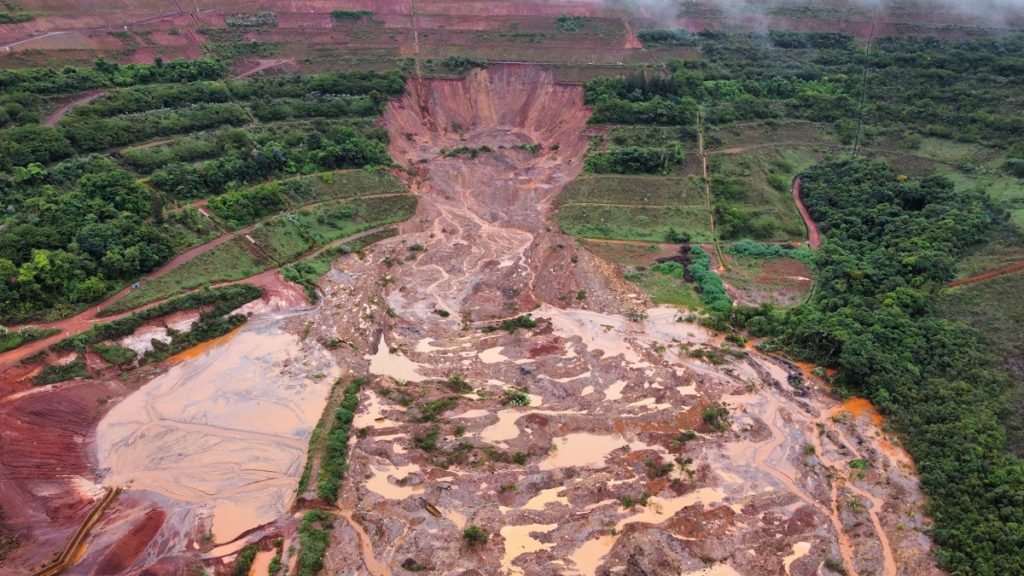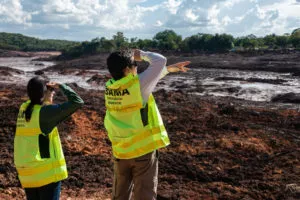Uma tradução em português do professor Marcos Pędłowski da Universidade Estadual do Norte Fluminense está disponível aqui.
Close to four hundred municipalities in the central Brazilian state of Minas Gerais declared a state of emergency after unusually heavy rains hit the region in early January. Widespread flooding submerged houses, blocked roads, and led to dozens of deaths and hundreds of thousands of evacuations. While extreme flooding is devastating under any circumstances, many communities in the region face another even more threatening situation: potentially unstable mine waste storage facilities that could collapse at any moment.

While mining companies are quick to blame heavy rainfall for the problems with their tailings dams, dam instability is the result of years of decisions that prioritize profits over safety. Safer, more resilient tailings dams are more expensive to build and maintain. Mining companies have chosen cheaper options, like upstream dams, for tailings disposal.
As climate change brings increasingly severe and extreme weather conditions, tailings dams designed and constructed to maximize profits will put more and more downstream communities at risk.
Brazil’s iron ore mines store their waste in earthen dams, called tailings dams, built from mine waste materials. Tailings dams, especially those constructed using upstream raises, are particularly prone to collapse if the tailings become saturated and the water level behind the dam rises. Before the rains started, the National Mining Agency (ANM in Portuguese) had already classified 36 dams in Minas Gerais (of the 40 nationwide) as being potentially at risk of failure. Three of those dams are at “imminent risk of collapse,” posing a terrifying threat to downstream communities.
Additionally with the recent rains, the Brazilian government specifically questioned the drainage systems and signs of erosion on 18 dams owned by Brazilian mining giant Vale as signs of potential failure. The Public Ministry’s office gave Vale 10 days to provide a report on what actions the company plans to take to ensure these dams do not collapse.
On Saturday January 8, a waste pile collapsed at French steel pipe producer Vallourec’s Pau Branco iron ore mine. Mine waste flowed into a water retention dam on site, which caused the dam to overflow.
Here are stunning videos of the event and the aftermath.
The waste pile was a co-disposal stack of waste rock and tailings, and was registered as a tailings dam with the ANM. The overflow flooded a major highway, sweeping away cars and leading to a two-day road closure. It also forced the evacuation of a staff member and 400 animals that the Wild Animal Rehabilitation Center (CRAS in Portuguese) located below the mine.
According to the Observatório de Mineração, “a equipe responsável pela operação, cerca de 60 pessoas em 21 veículos, enfrentou os riscos de ir a uma área interditada, com ameaça de rompimento detectada pela Agência Nacional de Mineração.” [the team responsible for the evacuation, around 60 people in 21 vehicles, faced the risks associated with going into an emergency area with the threat of [dam] break detected by the National Mining Agency.]
Brazilian regulators fined the company $51.6M USD for the spill and suspended operations at the mine. This disaster did not come as a surprise to community organizations and local officials who had raised concerns about the stability of the waste disposal stack in 2021. Their warnings were ignored by the company and Brazilian regulators.
On the 11th, a dam at the Mar Azul mine, one of the three dams classified as at imminent risk of collapse, reportedly broke and sent tailings into downstream water bodies. Vale, the mining company that owns the three high-risk dams, released a statement saying the dam’s structural integrity had not been compromised and the runoff was caused by mudslides on the face of the structure. The downstream community has expressed fear that the entire dam will collapse. They have also been stranded by flooding. Recently, Vale built a 10 story retention wall to mitigate a potential tailings dam failure. The wall has caused rain waters to back up into the downstream community of Macacos. 58 families were evacuated and another 12 were stranded by floodwaters.
The community of Macacos isn’t alone in fearing a dam collapse. Dozens of communities across Minas Gerais are facing similar circumstances. The town of Congonhas is worried about the possible collapse of the CSN Casa de Pedra dam as water builds up behind the structure. An independent review of the dam identified possible stability issues in 2019 and with the recent flooding the ANM has raised its emergency classification to “not-controlled.”
The current disaster is unfolding in Brazil, but there have been at least seven tailings dam spills and failures in the last two months across the world. Governments must implement strong tailings regulations guided by public safety, like those outlined in Safety First: Guidelines for Responsible Mine Tailings Management.
The Movement of People Affected by Dams is asking for international solidarity to donate to humanitarian aid efforts for the thousands of people still living in emergency situations caused by the flooding and the unstable tailings dams. Donations can be made via wire transfer with the information below or via PayPal with this link.
Your Support Makes Our Work Possible
Earthworks helps families on the front lines of mining, drilling, and fracking. We use sound science to expose health, environmental, economic, social, and cultural impacts of mining and energy extraction. To support our efforts, please consider a tax-deductible donation today that will go toward our work reforming government policies, improving corporate practices, influencing investment decisions, and encouraging responsible materials sourcing and consumption.

